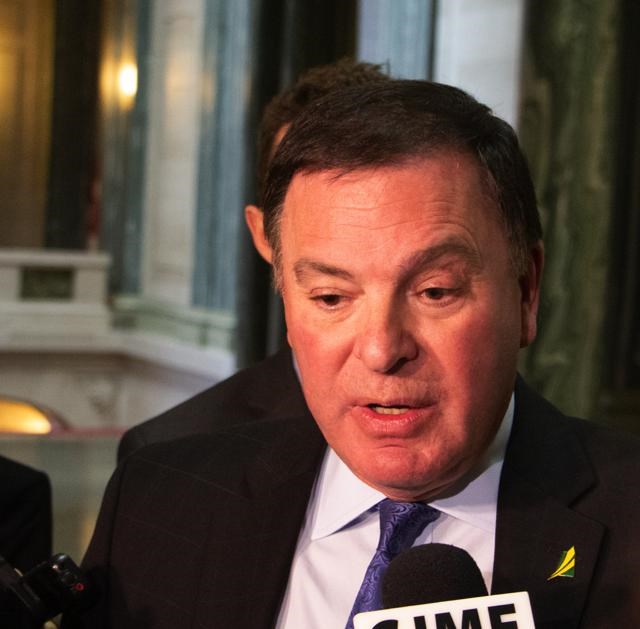The provincial government is recommending schools enact protocols like wearing masks in high traffic areas, but not mandating it. The ultimate decision, according to Education Minister and Deputy Premier Gord Wyant, will be up to the 27 school divisions. Instead, he said the province will be “providing guidance to ensure school divisions have the public health information they need to make their decisions for their local school divisions.”
And while Chief Medical Health Officer Dr. Saquib Shahab suggests schools should start at “Level 2” on a four-level scale of COVID-19 based restrictions, he’s also not ordering them to do so.
Those were the key points of the Aug. 11 provincial government COVID-19 briefing, focusing on getting kids back to school.
Wyant said, “With a number of divisions expressing interest in mandating mask usage, it is recommended the requirement to wear a mask will be specific to high traffic areas, such as in hallways and on school buses. This should apply to all students in Grades 4 through 12, or those students in Grades 9 through 12 masks may also be required in classrooms where it's not possible to maintain a level of physical distancing. The guidance on mask usage would also apply to teachers, and to staff.
“Regarding the use of Level 2, students and staff are encouraged to bring their own non-medical cloth masks.”
Wyant said the province had secured six million disposable masks for schools, with an initial cost of $2.3 million. They will be made available to students, teachers and staff at the beginning of the year, and on a daily basis.
He noted that school divisions are seeking clarification on Level 3 with regards to high schools with a high density population. This level would provide for hybrid learning models and may include alternate instructional days.
Additional measures to be included in all divisional plans includes teachers in class cohorting, cohorting (grouping) teachers to a limited number of students and keeping students in one cohort as much as possible. For elementary schools, the cohort will be the classroom. In high schools, Wyant said, “School divisions will be encouraged to find creative solutions to move students in cohorts wherever that is possible.”
He noted staggered start times, breaks and end times as possibilities.
Shahab said, “We would probably be better off starting at a higher level, Level 2, or mask use, initially, and then we can recalibrate as things settle down.”
He suggested some of the largest schools start at Level 3 and then recalibrate.
Shahab said that everyone should have two or three reusable masks, and that includes students.
He said students should remain within their own cohorts while at school as well. “You can be closer together with that consistent set of friends, but generally avoid mingling with large number of students in the school setting.”
Wyant said school divisions “have the best information at a local level with respect to the realities in their classrooms and in their schools.”
Shahab said the idea of moving between levels developed from experience with schools in Europe and southeast Asia which have continued to have school in recent months. He said we need to look at new evidence, be flexible and not rigid, and support processes that minimize disruption.
Shahab noted that Saskatchewan’s reopening has gone very smoothly, with occasional transmission of COVID which has been managed. “We would expect the same to happen in school, even though the school is a very large sector that’s reopening,” he said, adding the importance of being sensitive to the concerns of parents, students and staff.
Wyant said, “So my message to parents today is that they can be very confident in the local plans that have been developed by those school divisions because they've all been done, not only in consultation with public health and with chief medical health officer, but with educational professionals who have vetted those plans. And so, I feel very confident in the plans. I know public health feels very confident in the plans and as additional guidance, may be directed through the achievement by the chief medical health officer will continue to provide that guidance, but certainly the local plans are responsive to the local conditions and I think that school divisions have done an excellent job in preparing those plans so that children return to school in the fall in the safest way possible.”
NDP reaction
NDP education critic Carla Beck disagreed, saying in a statement, “After the latest update from the Education Minister today, I continue to be astounded by this government’s complete lack of planning for a safe return to schools.
“The Minister of Education announced further potential measures that divisions might choose to enforce for the upcoming school year. Let us be clear: further guidance is badly needed, but the guidance they’ve provided so far is not nearly enough. Parents still do not know when, and under what conditions, mask use will be mandatory.
“Saskatchewan parents, students, teachers, and school-based staff are still stuck with the worst plan in the country,” Beck said.
“Saskatchewan families have done what has been asked of them during the pandemic. The least we expect is a real plan to get our kids back to school safely. It is incredibly frustrating that once again the government has chosen to direct school divisions to “find creative solutions” rather to provide clear guidance or funding on cohorting and physical distancing.
She concluded, “I have called on the Minister to reconvene the Human Resources Committee to hear expert testimony for a real plan that puts school safety first. We must get this right.”



